Introduction
Domesticated goats are a subspecies of the wild goats of southwest Asia and eastern Europe and are a member of the Bovidae family.1https://www.livescience.com/52540-goat-facts.html There are just under a billion goats across the world today with over 200 distinct breeds. They were one of the first animals to be domesticated and used by humans, at least 10,000 years ago.2https://nationalzoo.si.edu/animals/goat Wild goats still live around the world, mostly in southwestern Asia. Wild goats have a lifespan of 8 to 12 years, and they can live to 18 years old in sanctuaries.
Fascinating facts
Billy goat gruff

Male goats are called “bucks” or “billys” and usually have a little beard beneath their chin. This is where the “goatee” beard sported by many human men gets its name. Female goats are called “does” or “nannys”, while young goats are called “kids”.
Contrary to popular belief, goats won’t eat just anything
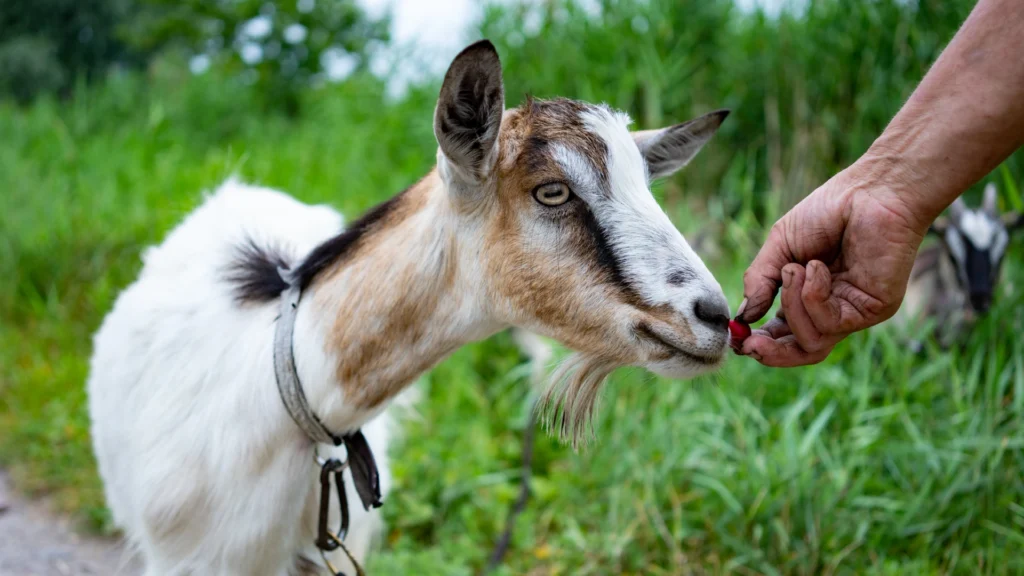
They are browsers, meaning that they will explore and eat a diverse range of vegetation such as roots and shrubs and will even climb trees to reach particularly tasty leaves.3https://www.nationalgeographic.com/travel/article/video-watch-bizarre-tree-climbing-goats-in-action-morocco Goats might be coffee lovers. Legend has it that goats discovered coffee’s excitable effects after people noticed them dancing whenever they ate coffee berries.4https://www.ncausa.org/About-Coffee/History-of-Coffee
Clever communicators
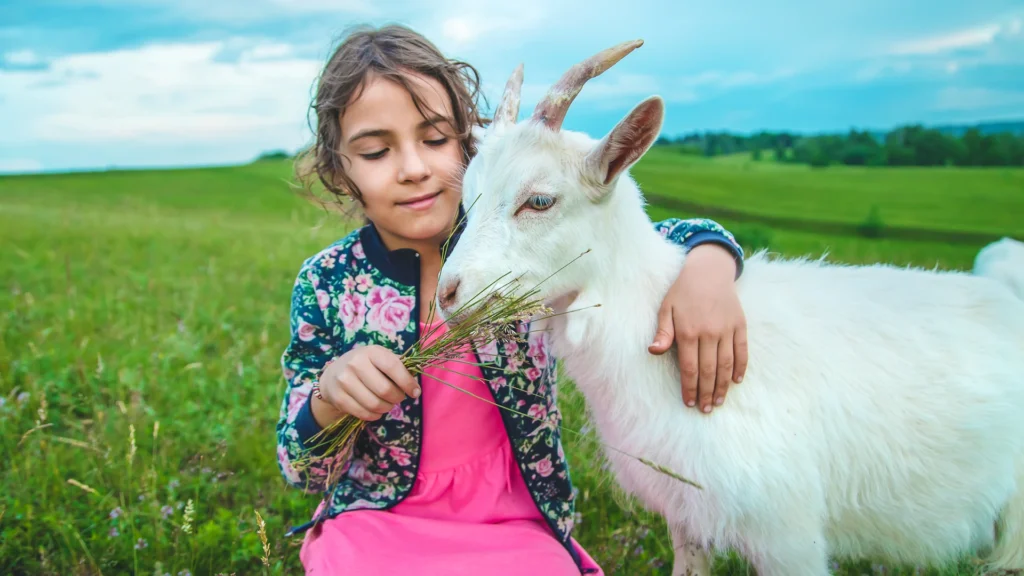
Goats can communicate with people in much the same way as dogs and cats do, and form strong bonds with us when given the opportunity.5https://royalsocietypublishing.org/doi/full/10.1098/rsbl.2016.0283 However, you’re more likely to make friends with a goat if you have a smile on your face, A 2018 study6https://www.bbc.co.uk/newsround/45343152?intlink_from_url=https://www.bbc.co.uk/news/topics/cly49x4jp6mt/goats&link_location=live-reporting-story revealed that goats prefer to hang around people with happy faces rather than those with angry expressions and that they have extraordinary communication skills with humans.
Goats have different accents
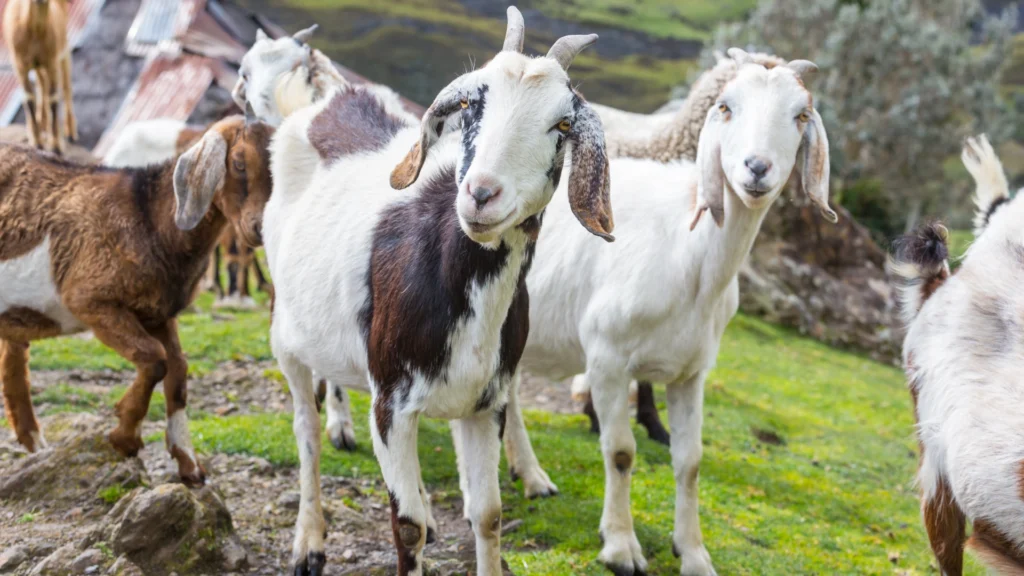
Along with elephants, dolphins and humans, goats have different accents depending on where they’re from and who their parents are. Kids (young goats) who are related share a similar accent and as they grow up, their accent becomes more similar to the other goats in the herd.7https://www.telegraph.co.uk/news/science/science-news/9085654/Goats-can-develop-their-own-accents.html
Goats are excellent climbers and can even climb to the top of trees!
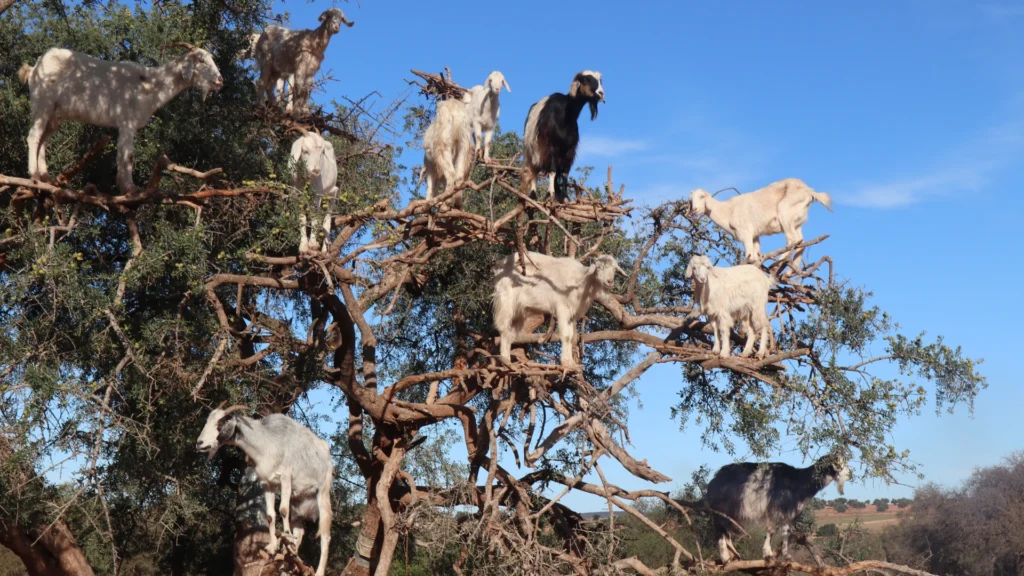
In Morocco, goats climb 30 feet up trees to reach their favourite foods.3https://www.nationalgeographic.com/travel/article/video-watch-bizarre-tree-climbing-goats-in-action-morocco Goats can also climb cliffs and mountains that look completely vertical. They have special hooves with rubbery pads which can spread out and grip onto surfaces and help with their brilliant balance.8https://animal-club.co.uk/goats-climb-walls/ In fact, mountain goats can climb up 450 metres vertically in less than 20 minutes!9http://justfunfacts.com/interesting-facts-about-mountain-goats/
Curious creatures!
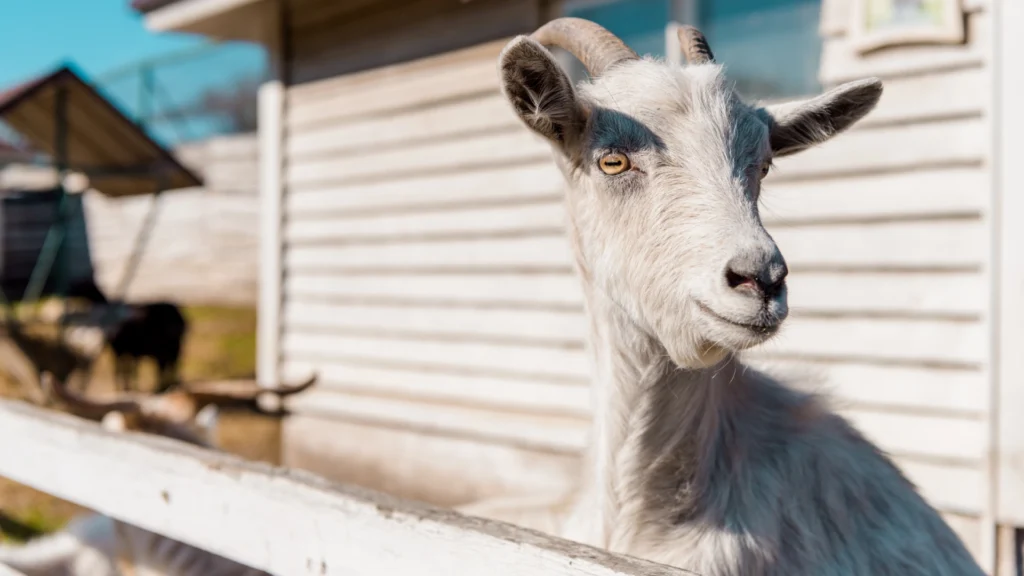
Goats are highly intelligent and curious and have a constant desire to explore – quickly investigating things that are unfamiliar. They can learn how to open gate latches and escape paddocks.2https://nationalzoo.si.edu/animals/goat
Goats sneeze as an alarm!

If you hear a goat sneeze, it doesn’t mean they have a cold but they might have noticed some danger. Goats sneeze to warn other goats of a threat. Some domesticated goats are known to faint when they are frightened. This is due to a genetic condition and doesn’t happen in wild goats or other goat breeds.10https://www.thoughtco.com/fainting-goat-4691940#
Goats have rectangular shaped pupils
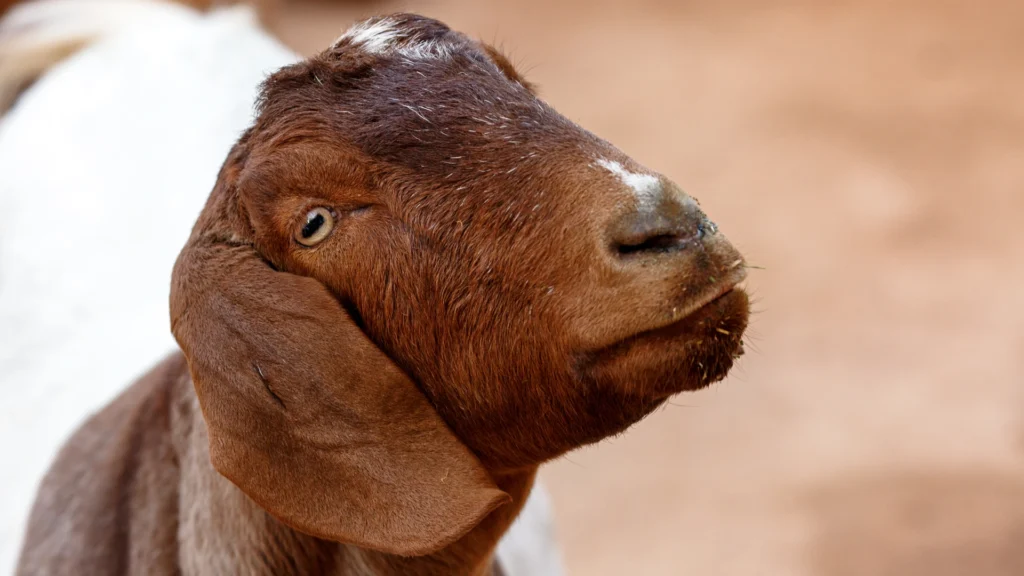
Goats (along with sheep, octopuses and toads) have rectangular shaped pupils.11https://www.science20.com/variety_tap/evolution_rectangular_eye This is because they’re always on the lookout for predators. The rectangular pupils give better depth perception in their peripheral vision, allowing them to accurately survey their surroundings and see approaching predators before it is too late.
Mum’s the word
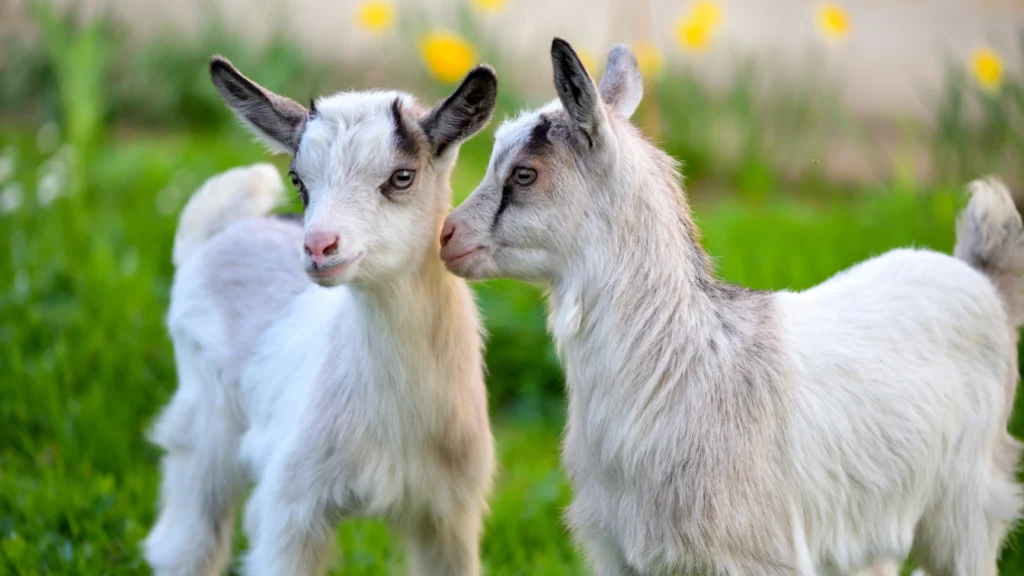
Goats are very capable mothers and often foster orphaned or rejected lambs, calves and even foals.12https://barrie.ctvnews.ca/goat-takes-on-motherly-role-for-orphaned-foal-in-coldwater-1.2553672 Female goats are usually pregnant for about five months before giving birth to twins or triplets – and sometimes quadruplets!13https://goats.extension.org/goat-reproduction-puberty-and-sexual-maturity/ Nanny mountain goats give birth on a narrow ledge, inaccessible to predators. The kids will stay by their mother’s side for a year, or until she becomes pregnant again.14https://www.mtgoats.ca/Facts/reproduction.asp Because of the harsh environment of the mountains (sub-zero temperatures, avalanches and predators), goat survival rates are low. Older females have a better chance of successfully producing young that will survive so the future of the herd depends on them.14https://www.mtgoats.ca/Facts/reproduction.asp
Goats in Uganda
There are currently over 17.5 million goats in Uganda15https://www.newvision.co.ug/category/business/observe-animal-rights-before-slaughter-NV_88846, a rise from 12.5 million in 200816https://core.ac.uk/download/pdf/132642444.pdf, and over half are female. Goats are farmed for milk, meat and breeding stock for other farmers.17https://naads.or.ug/goats/ Goat farming mainly takes place on smallholder farms, with around 40 per cent of households in Uganda farming goats.18https://en.sputniknews.africa/20240118/ugandan-scientists-reportedly-developing-improved-goat-breeds-to-boost-meat-production-1064685259.html
In 2003, Uganda produced 29,328 tonnes of goat meat19https://www.fao.org/3/ag377e/ag377e.pdf and this number has only risen over the past 20 years as more and more households and farmers turn to goat farming for income. In 2022, 3,021,985 goats were slaughtered in Uganda.20https://www.fao.org/faostat/en/#home
How goats are farmed
Goat farming is promoted to Ugandans as easy and low maintenance but nothing is further from the truth.21https://www.monitor.co.ug/uganda/magazines/farming/keep-goats-and-earn-more–3561700 If people enter into the industry with little experience and inaccurate expectations, both they and the goats will suffer.
Uganda farms three main breeds of goat for meat: the common East African goats, the Kigezi breed, and the Mubende breed.22https://www.farmingug.com/goats/goat-farming-in-uganda/ Goats farmed for their milk tend to be ‘exotic’ breeds including: the Anglo-Nubian goat, LaManchas, Alpines, Oberhaslis, Toggenbergs and Saanens.23Caring for Goat Kids (First 4 Months) | Goat farming in Uganda: Update 02 https://www.youtube.com/watch?v=MKatzzLgowM
Housing
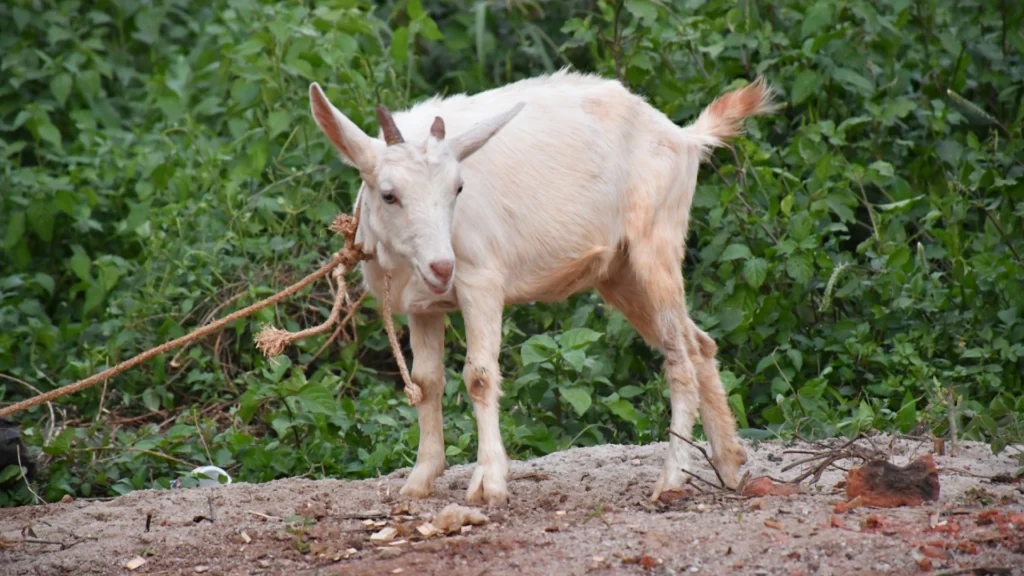
In Uganda, goats are raised in diverse environments, encompassing free-range, tethering, and zero-grazing systems. Each approach brings its own set of advantages and challenges, influencing the well-being of goats throughout their lifespans.
Free-range rearing allows goats to freely roam and graze in open spaces, creating a more natural setting. However, this freedom exposes them to environmental risks, parasites such as ticks, predators, and potential conflicts with human activities. The transformation of grassland to cropland not only affects Uganda’s wildlife, but has also reduced the amount of land that farmed goats have to graze.24https://www.researchgate.net/publication/275663503_Characterization_of_the_goat_feeding_system_among_rural_small_holder_farmers_in_the_semi-arid_regions_of_Uganda At night, free-range goats should be brought into a barn for their protection but the goats don’t have much room to move around – often only one square metre of space per goat.21https://www.monitor.co.ug/uganda/magazines/farming/keep-goats-and-earn-more–3561700
Tethering is common and can be seen across Uganda on small household farms. It involves securing goats to a fixed point with a short tether, restricting their movement and access to natural grazing areas. This practice can induce great stress, discomfort, and injuries due to limited mobility and a lack of natural foraging opportunities. Goats would naturally consume 48 different plant species, but that is massively reduced by tethering.24https://www.researchgate.net/publication/275663503_Characterization_of_the_goat_feeding_system_among_rural_small_holder_farmers_in_the_semi-arid_regions_of_Uganda
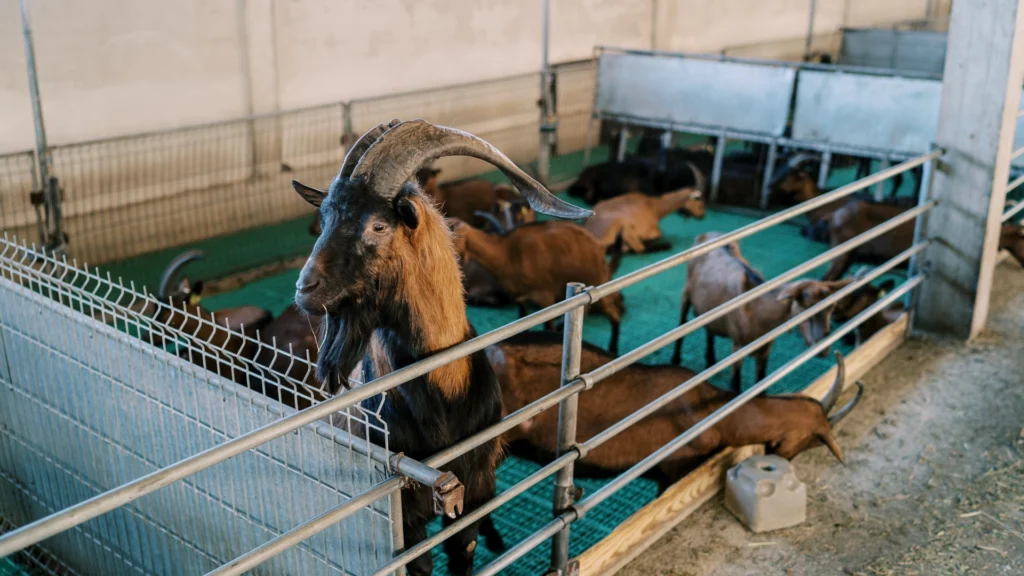
Zero grazing (where the goats are not allowed to graze) confines goats in enclosed spaces, controlling feeding and stopping natural grazing, resulting in huge stress and physical discomfort due to restricted movement. Zero grazing is most common on larger-scale farms.25Profiting from dairy goat farming in Uganda | SEEDS OF GOLD https://www.youtube.com/watch?v=TREuBaXGBWI On zero grazing farms, goats are either confined individually in small cubicles or in a ‘dormitory’ system where several goats are kept in a fenced pen with a wooden slatted floor. This system is the furthest removed from the natural environment of a goat.
Milking
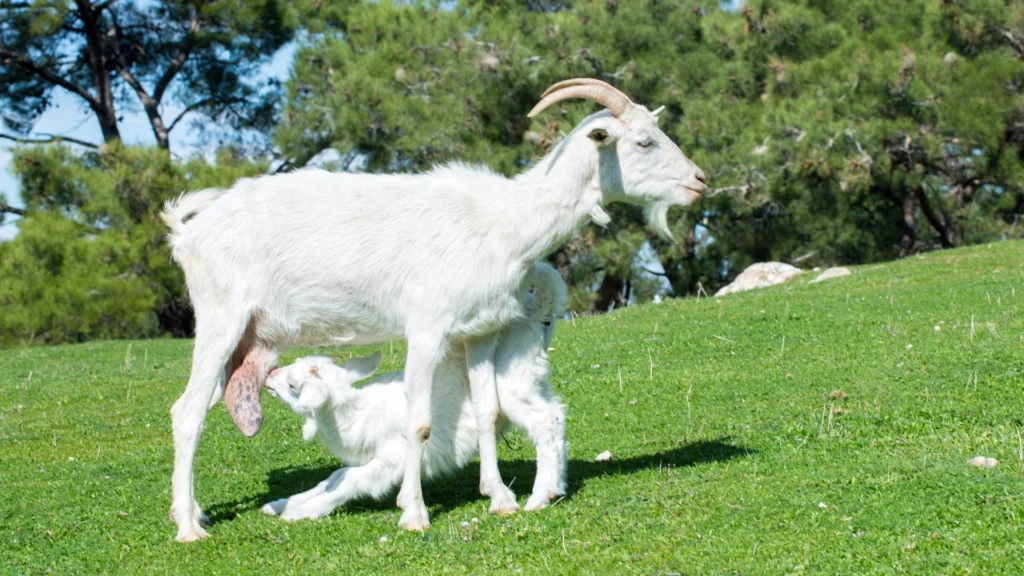
Goats can only be milked if they’ve given birth to a kid. Various methods, such as artificial insemination, natural mating, or embryo transfer, are employed for goat insemination in Uganda. A female goat produces 1.8 goats per year on average24https://www.researchgate.net/publication/275663503_Characterization_of_the_goat_feeding_system_among_rural_small_holder_farmers_in_the_semi-arid_regions_of_Uganda – or two kids every 13 months.26How To Ensure Your Goats Kid Twice In 13 Months https://www.youtube.com/watch?v=OwoWHS7K7ak

After a mother goat has given birth to a kid, the baby is left with the mother for the first day and/or night so that they can feed and bond with their mother. If they are not allowed this time to bond, the mother may reject her kid when she is later brought back to feed them.27How to care for pregnant goats to get healthy kids and maintain a happy herd – 2023 https://www.youtube.com/watch?v=Rn1U6oEDjLg Baby goats are not allowed to graze with their mothers and other adults (as it is believed they have more delicate stomachs and are susceptible to becoming infected with parasitic worms28She Quit From Being A University Lecturer To Start The Biggest Goat Farm in Uganda https://www.youtube.com/watch?v=VjgIC4P5Rh0). Kids are kept in sheds or separate paddocks for up to four months before they are allowed out to graze and socialise with adults.23Caring for Goat Kids (First 4 Months) | Goat farming in Uganda: Update 02 https://www.youtube.com/watch?v=MKatzzLgowM During this time, either the mother is brought in to feed her kid, the farmer will feed the kids by bottle or the kid will be trained to drink from a bucket.29https://naads.or.ug/wp-content/uploads/2024/01/GOAT-PRODUCTION-MANUAL-JULY-2023-2022docx_240112_100629.pdf The separation of mother and baby causes distress to both.
Challenges faced by goats
The most common illness affecting dairy goats is mastitis.25Profiting from dairy goat farming in Uganda | SEEDS OF GOLD https://www.youtube.com/watch?v=TREuBaXGBWI Mastitis occurs when the goat’s udder becomes inflamed and infected. This can be caused by physical injury – for example, rough handling of the animal by the farmer when being milked – stress, and bacteria from unhygienic housing. Mastitis can lead to pus and blood cells making its way into the milk.30https://www.canr.msu.edu/news/mastitis-in-sheep-and-goats
Goats and sheep are also prone to respiratory illnesses caused by the dust in the animal house and the mud around the farm can lead to hoof rot.31https://www.agriculture.go.ug/wp-content/uploads/2021/10/GUIDELINES-FOR-IPC-APPROPRIATE-ANTIBIOTIC-USE-ANIMAL-SECTOR-GOAT-FARMING.pdf Outbreaks of Goat Plague, or peste des petits ruminants (PPR) are also common in Uganda. In 2021, hundreds of goats died of the disease32https://www.independent.co.ug/plague-kills-200-goats-in-hoima/, which causes fever, discharge from eyes, coughing, diarrhoea and eventually death.33https://www.gov.uk/guidance/goat-plague#how-to-spot-goat-plague
Treating sick goats is challenging due to inadequate facilities and resources, and the high cost of veterinary care poses a problem for small-scale farmers. This means many sick goats will go untreated, either left to suffer or be euthanised.
Despite misconceptions that goats will eat absolutely anything, they actually need high-quality feed. Goats consume large quantities of fresh forage and high-quality hay. This can be very expensive for farmers and good pastureland can be hard to find. Developing a pasture that can support goats requires a lot of knowledge29https://naads.or.ug/wp-content/uploads/2024/01/GOAT-PRODUCTION-MANUAL-JULY-2023-2022docx_240112_100629.pdf and will likely be unachievable for many farmers with financial and land constraints. The type of feed provided significantly impacts goat welfare, as incorrect nutrition can lead to health issues for adult goats and developmental problems with their kids.
How goats are killed
Goats are slaughtered in four different, but equally cruel, settings. First there is family slaughter, where a family kills a goat at home to feed the family. Secondly there is slaughter at a “slaughter slab”, either in a village or town. Then there are small slaughterhouses, and larger city abattoirs.

Transportation to slaughterhouses poses serious welfare concerns for goats in Uganda. Goats are often transported long distances in unsuitable trucks, causing stress, injuries, and prolonged discomfort. During transportation, goats face various hazards, including group stress, handling stress, heat stress, injuries, motion stress, prolonged hunger, and sensory overstimulation, all negatively affecting their welfare. Goats are often transported with cattle, which can easily trample and kill the smaller and weaker goats. In some trucks, goats are transported on rickety, makeshift second decks, above the cows where they can easily fall and become injured, even if they’re tied up.15https://www.newvision.co.ug/category/business/observe-animal-rights-before-slaughter-NV_88846
All goats killed in Uganda are “live slaughtered”15https://www.newvision.co.ug/category/business/observe-animal-rights-before-slaughter-NV_88846, meaning they are not stunned before having their throats slit and being left to bleed to death in a pool of their own blood and faeces on a filthy concrete floor. Politicians in Uganda are looking to export meat products – including goat meat – to Muslim countries such as Qatar, where animals must be killed while they are still conscious to conform to halal standards.34https://nilepost.co.ug/news/182428/mps-want-slaughtering-of-animals-restricted-to-muslims
In family slaughter, goats have their front and hind legs tied together and are pinned to the ground. One of the family members – often just a child – holds the goat’s head back to stretch out their neck. Someone then uses a knife to slit the goat’s throat. Blunt knives mean the goat is subjected to severe pain and suffering as the blade is sawed across their neck for what must feel like an eternity for the goat, while they hopelessly fight for their life.35How A Goat Is Slaughtered In Uganda: https://www.youtube.com/watch?app=desktop&v=lIdDbO9c0qo
Slaughtering conditions in Uganda are a major concern, with a majority occurring in unhygienic environments lacking proper waste disposal systems, increasing the risk of zoonotic infections (where diseases jump from animal to human). Kampala City Abattoir slaughters 200-300 goats and sheep a day36https://www.newvision.co.ug/category/news/foreign-investors-eye-kampala-city-abattoir-NV_93598 in very unhygienic conditions. These conditions contribute to additional stress and suffering for goats during the final stages of their short lives – goats reach the desired slaughter weight at just eight months old, so they’re still only young when their life is taken.37https://www.farmuganda.com/goats-farming-3/
Whether kept on a small family farm or in an intensive system, goats farmed for milk and meat face abhorrent cruelty in their short lives. From the moment they are separated from their mothers to the moment their life is taken from them, they never get to experience a natural life. If you truly want to respect the life of these animals, the only answer is to not eat them. Go vegan for the goats!
References
References
- 1
- 2
- 3
- 4
- 5
- 6
- 7
- 8
- 9
- 10
- 11
- 12
- 13
- 14
- 15
- 16
- 17
- 18
- 19
- 20
- 21
- 22
- 23Caring for Goat Kids (First 4 Months) | Goat farming in Uganda: Update 02 https://www.youtube.com/watch?v=MKatzzLgowM
- 24
- 25Profiting from dairy goat farming in Uganda | SEEDS OF GOLD https://www.youtube.com/watch?v=TREuBaXGBWI
- 26How To Ensure Your Goats Kid Twice In 13 Months https://www.youtube.com/watch?v=OwoWHS7K7ak
- 27How to care for pregnant goats to get healthy kids and maintain a happy herd – 2023 https://www.youtube.com/watch?v=Rn1U6oEDjLg
- 28She Quit From Being A University Lecturer To Start The Biggest Goat Farm in Uganda https://www.youtube.com/watch?v=VjgIC4P5Rh0
- 29
- 30
- 31
- 32
- 33
- 34
- 35How A Goat Is Slaughtered In Uganda: https://www.youtube.com/watch?app=desktop&v=lIdDbO9c0qo
- 36
- 37

